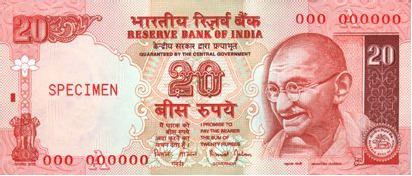Value ₹20 Height 63 mm Design Mahatma Gandhi | Width 147 mm Years of printing August 2001 – present | |
 | ||
Security features Secure thread, latent image, micro-lettering, intaglio print, fluorescent ink, optically variable ink, watermark, and see through register. | ||
The Indian 20-rupee banknote (₹20) is a common denomination of the Indian rupee. The current ₹20 banknote in circulation is a part of the Mahatma Gandhi Series. The Reserve Bank introduced the ₹20 note in the Mahatma Gandhi Series in August 2001. Making it one of the last denominations of the series to be introduced in the series; other than the ₹5, which was introduced in November 2001.
Contents
It was first introduced by the Reserve Bank of India in 1972 to contain the cost of production of banknotes in circulation. With the introduction of this banknote, the Reserve Bank started a major redesign of the motif of the Lion Capital Series banknotes.
Design
The ₹20 banknote of the Mahatma Gandhi Series is 147 × 63 mm Red-orange coloured, with the obverse side featuring a portrait of Mahatma Gandhi with a signature of the governor of Reserve Bank of India. It has the Braille feature to assist the visually challenged in identifying the currency. The reverse side features a motif of Mount Harriet and Port Blair light house.
As of 2012, the new ₹ sign has been incorporated into banknote of ₹20. In January 2014 RBI announced that it would be withdrawing from circulation all banknotes printed prior to 2005 by 31 March 2014. The deadline was later extended to 1 January 2015. Now further dead line was extended to 30 June 2016.
Security feature
The security features of the ₹20 banknote includes:
Languages
As like the other Indian rupee banknotes, the ₹20 banknote has its amount written in 17 languages. On the obverse, the denomination is written in English and Hindi. On the reverse is a language panel which displays the denomination of the note in 15 of the 22 official languages of India. The languages are displayed in alphabetical order. Languages included on the panel are Assamese, Bengali, Gujarati, Kannada, Kashmiri, Konkani, Malayalam, Marathi, Nepali, Odia, Punjabi, Sanskrit, Tamil, Telugu and Urdu.
